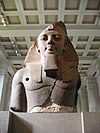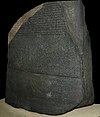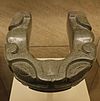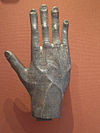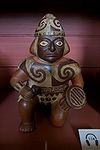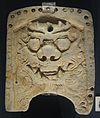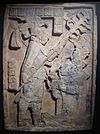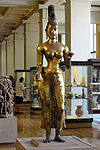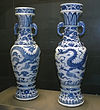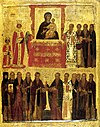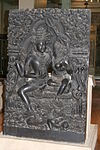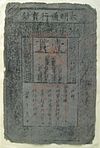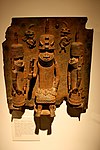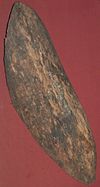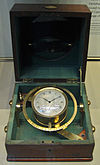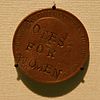
The Lewis chessmen or Uig chessmen, named after the island or the bay where they were found, are a group of distinctive 12th-century chess pieces, along with other game pieces, most of which are carved from walrus ivory. Discovered in 1831 on Lewis in the Outer Hebrides of Scotland, they may constitute some of the few complete, surviving medieval chess sets, although it is not clear if a period-accurate set can be assembled from the pieces. When found, the hoard contained 93 objects: 78 chess pieces, 14 tablemen and one belt buckle. Today, 82 pieces are owned and usually exhibited by the British Museum in London, and the remaining 11 are at the National Museum of Scotland in Edinburgh.
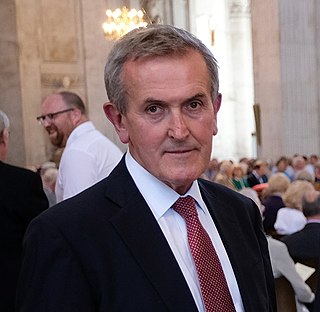
Robert Neil MacGregor is a British art historian and former museum director. He was editor of the Burlington Magazine from 1981 to 1987, then Director of the National Gallery, London, from 1987 to 2002, Director of the British Museum from 2003 to 2009, and founding director of the Humboldt Forum in Berlin until 2018.

Neil Nightingale is a British freelance wildlife filmmaker, executive producer and creative consultant with over 35 years experience at the BBC. From 2009 to 2018 he was the creative director of BBC Earth, BBC Worldwide's global brand for all BBC nature and science content.
Mikhail Mikhailovich Adamovich (1884–1947) was a Russian decorative and monumental painter, and porcelain artist. He is known for his porcelain works with agitprop and Soviet art imagery.

Our Top Ten Treasures was a 2003 special episode of the BBC Television series Meet the Ancestors which profiled the ten most important treasures unearthed in Britain, as voted for by a panel of experts from the British Museum.

Hornedjitef was an ancient Egyptian priest in the Temple of Amun at Karnak during the reign of Ptolemy III. He is known from his elaborate coffins, mummy mask and mummy, dating from the Early Ptolemaic Period and excavated from Asasif, Thebes, Egypt, which are all held in the British Museum. These related objects were chosen as the first of the hundred objects selected by British Museum Director Neil MacGregor in the 2010 BBC Radio 4 series A History of the World in 100 Objects.

The El-Amra clay model of cattle is a small ceramic sculpture dating from the Predynastic, Naqada I period in Ancient Egypt, at around 3500 BC. It is one of several models found in graves at El-Amra in Egypt, and is now in the British Museum in London. The model is 8.2 centimetres high, 24.2 cm long and 15.3 cm wide. The model was made from clay, and fired at a low temperature before it was painted, however most of the paint is lost.

The Sphinx of Taharqo is a granite gneiss statue of a sphinx with the face of Taharqo. He was a Nubian king, who was one of the 25th Egyptian Dynasty rulers of the Kingdom of Kush. It is now in the British Museum in London.

The Minoan bull leaper is a bronze group of a bull and leaper in the British Museum. It is the only known largely complete three-dimensional sculpture depicting Minoan bull-leaping. Although bull leaping certainly took place in Crete at this time, the leap depicted is practically impossible and it has therefore been speculated that the sculpture may be an exaggerated depiction. This speculation has been backed up by the testaments of modern-day bull leapers from France and Spain.

Hedwig glasses or Hedwig beakers are a type of glass beaker originating in the Middle East or Norman Sicily and dating from the 10th-12th centuries AD. They are named after the Silesian princess Saint Hedwig (1174–1245), to whom three of them are traditionally said to have belonged. So far, a total of 14 complete glasses are known. The exact origin of the glasses is disputed, with Egypt, Iran and Syria all suggested as possible sources; if they are not of Islamic manufacture they are certainly influenced by Islamic glass. Probably made by Muslim craftsmen, some of the iconography is Christian, suggesting they may have been made for export or for Christian clients. The theory that they instead originate from Norman Sicily in the 11th century was first fully set out in a book in 2005 by Rosemarie Lierke, and has attracted some support from specialists.

The Mechanical Galleon is an elaborate nef or table ornament in the form of a ship, which is also an automaton and clock. It was constructed in about 1585 by Hans Schlottheim in southern Germany. It was in the possession of Augustus, Elector of Saxony. The model is now in the British Museum in London. Two other similar models are located in museums in France and Austria, the Château d'Écouen and the Kunsthistorisches Museum.

The Double-headed serpent is an Aztec sculpture. It is a snake with two heads composed of mostly turquoise pieces applied to a wooden base. It came from Aztec Mexico and might have been worn or displayed in religious ceremonies. The mosaic is made of pieces of turquoise, spiny oyster shell and conch shell. The sculpture is at the British Museum.
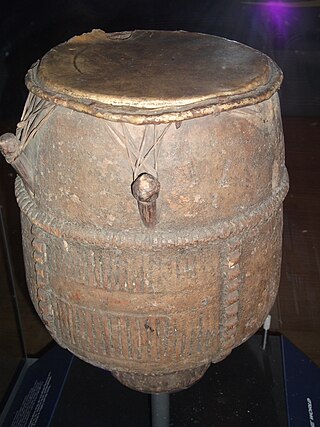
The Akan Drum is a drum that was made in West Africa and was later found in the Colony of Virginia in North America. It is now one of the oldest African-American object in the British Museum and possibly one of the oldest surviving anywhere. The drum is a reminder of all three continents' involvement in the estimated twelve million people transported across the Atlantic Ocean as part of the transatlantic slave trade. The drum is normally displayed in Room 26, the North American gallery, in the British Museum.

The Throne of Weapons is a 2002 sculpture created by Cristóvão Canhavato out of disused weapons. It is owned by the British Museum and has been called the Museum's most "eloquent object" and has been shown in a wide variety of ways.
Alistair Craig Clunas is Professor Emeritus of History of Art at the University of Oxford. As a historian of the art and history of China, Clunas has focused particularly on the Ming Dynasty (1368–1644).

The Kang Hou gui is a bronze vessel that is said to have been taken from the city of Huixian, Henan province, central China. Dating to the Western Zhou period, this ancient Chinese artefact is famous for its inscription on the bottom of the interior. It has been part of the British Museum's Asian Collections since 1977.
Maria Jane Balshaw CBE is director of the Tate art museums and galleries. The appointment was confirmed by Theresa May, the UK Prime Minister at the time, on 16 January 2017, making Balshaw the first female director of the Tate.

Germany: Memories of a Nation is a 2014 book by British historian and then director of the British Museum, Neil MacGregor. The work was published in conjunction with his BBC Radio 4 series and a major exhibition at the British Museum.

Living with the Gods is a 30-part BBC Radio 4 series presented by Neil MacGregor, a former director of the British Museum. It explores human societies and what MacGregor describes as "the connections between structures of belief, and the structures of society". The series examines artefacts from the 40,000 year-old Lion-man sculpture to the contemporary Lampedusa Cross created by Francisco Tuccio in response to the 2013 drowning of refugees off the island of Lampedusa.
The Reunion is a radio discussion series presented by Kirsty Wark which reunites a group of people involved in a moment of modern history. It has been broadcast on BBC Radio 4 since July 2003, with 163 episodes presented by the first presenter, Sue MacGregor.



















